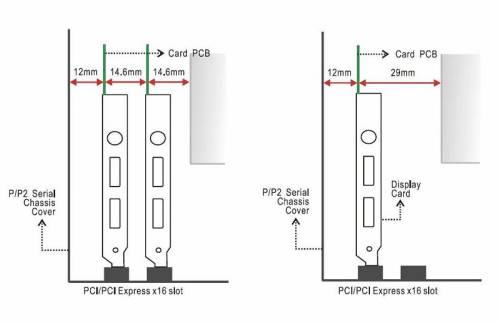Table of Contents
Graphics Card-related FAQ
Does a PCI-E x4 card fit in a x16 slot?
I just purchased a Shuttle XPC cube Barebone. It has only one PCI-E x16 slot, however I have an old PCI-E x4 card. Can I use this card with the PCI-E x16 slot?
Yes, a single-lane PCI-E (x1) card can be inserted into a multi-lane slot (PCI-E x4, PCI-E x8, etc.), but may not fit into a smaller PCI-E slot (e.g. a PCI-E x16 card in a x8 slot). However, some motherboards have PCI-E slots that use open-ended sockets to permit physically longer PCI-E cards to work. An example is an x1 slot that allows for all x1, x2, x4 , x8 or x16 cards, even though it would run at only x1 speed.
Does my Shuttle XPC support the latest NVIDIA GeForce or AMD Radeon graphics card? Is the Shuttle power supply sufficient enough to support such a card?
The power supply unit can be counted on to deliver sufficient power without any difficulties. You will only need to double-check whether the video card will fit in the case. Cards with a dual fan system (dual-slot cards, or cards with an exceptionally large fan) may just be too large. The only exception are the P/P2/H7/J1/J2/J3-Series chassis types.
- Please take a look at our Compatibility List which also details supported processors and memory: https://global.shuttle.com/support/supportList
- You may also check the Power Supply Calculator to learn more about power consumption of different processors, graphics cards and other components: https://global.shuttle.com/support/power
What is the maximum size of a VGA card that fits in my XPC?
There are several different XPC product series with PCI Express slots: G-, P/P2-, H-, J- and R-Series, as well as the XPC slim in 3 litre and 4.7 litre format.
XPC slim
4.7-litre format w/ PCIe slot
The maximum size of a card that fits in this model is 205 mm (L) × 120 mm (H) × 45 mm (D).

3-litre format w/ PCIe slot
The maximum size of a card that fits in this model is 208.5 mm (L) × 120 mm (H) × 30 mm (D).

XPC cube
R8-Series
The maximum size of a card that fits in the R8-Series is 280 mm (L) × 120 mm (H) × 40 mm (D).

J-Series, R-Series (R4, R6)
The maximum size of a card that fits in the J-Series is 273 mm (L) × 98 mm (H) × 38 mm (D). But due to the different layout designs of each model and VGA card, we strongly suggest to check our VGA support list for each model or test before purchasing the VGA card.



H-Series
The maximum size of a card that fits in the H-Series is 267 mm (L) × 98 mm (H) × 18/34 mm (D).


G-Series
The maximum size of a card that fits in the G-Series is 206 mm (L) × 98 mm (H) × 16 mm (D). But due to the different layout designs of each model and VGA card, we strongly suggest to check our VGA support list for each model or test before purchasing the VGA card.


P/P2-Series
The maximum size of a card that fits in the P/P2-Series is 266 mm (L) × 98 mm (H) × 36 mm (D). But due to the different layout designs of each model and VGA card, we strongly suggest to check our VGA support list for each model or test before purchasing the VGA card.


Note: The P-Series requires the fan-duct to be removed in order to support a long-length VGA card. Burn-in tests without fan-duct have proven that the machine's thermal performance will not be affected.
My XPC auto-reboots and will not post after changing the video card. Why?
Problem: After changing the video card which is certain to be functional and also quoted on the Shuttle compatibility list, the POST screen is no longer displayed while the PC is in a boot loop.

Correct sitting of BIOS chip before removal of video card

BIOS chip mistakenly pulled from housing

BIOS chip partially detached from its housing
Solution: In some cases, the video card sits atop of the system BIOS chip. By removing the video card, the I/O shield of the video card might have accidentally hit the BIOS chip which, in result, caused the BIOS chip loosened from its housing. Please doublecheck the correct sitting of the BIOS chip before seeking further troubleshooting.
Integrated graphics memory size
Our Shuttle XPC products with Intel graphics have their GPU usually included in the CPU and do not have an own VRAM (Video RAM). They use a share of the system memory (RAM) instead. This technology is called Shared Memory or Uniform Memory Access (UMA).
Is it possible to change/limit the size of the VRAM? The BIOS/UEFI setting “IDG Memory Size Select” (e.g. 64 MB - 512 MB) has an effect during boot-up only. Once Windows and all drivers are loaded, the VRAM capacity and usage will be managed dynamically (up to 2 GB).



No screen or black screen after graphics card installation?
This problem often has a mechanical cause or missing electrical connections. Therefore, check the correct installation first.
- Is the graphics card connected to the additionally required power connectors?


- Is the graphics card correctly inserted in the PCI Express slot? No contacts may be exposed!


